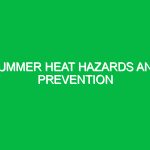Seasonal Workplace Hazards represent a crucial aspect of Health, Safety, and Environment (HSE) that every organization must address. As the seasons change, so do the risks associated with various work environments. Understanding these hazards is not just about compliance; it’s about cultivating a culture of safety that protects employees and enhances productivity. In this article, we will explore the various types of seasonal hazards, the risks they pose, and the best practices for mitigating these risks. We will also touch on relevant regulations that govern workplace safety throughout the year.
What Are Seasonal Workplace Hazards?
Seasonal Workplace Hazards are risks that arise due to seasonal changes in weather, temperature, and environmental conditions. These hazards can vary significantly depending on the season and can affect different industries in unique ways. For instance, winter may bring icy walkways and increased risk of slips and falls, while summer might pose threats from heat exhaustion and sun exposure. Understanding these hazards is vital for both employees and employers, as they directly impact workplace safety and health.
Identifying Seasonal Hazards
Recognizing the potential hazards associated with each season is the first step in managing risks effectively. Below, we delve into specific hazards tied to each season, illustrating how they manifest in various workplace environments.
Winter Hazards
Winter introduces a myriad of hazards, primarily due to cold weather and snow. Slip and fall incidents are among the most common injuries, often caused by icy sidewalks and parking lots. In fact, according to the Bureau of Labor Statistics, slip and fall accidents account for a significant portion of workplace injuries during winter months.
Additionally, prolonged exposure to cold temperatures can lead to serious health issues such as frostbite and hypothermia. Employees working outdoors, such as construction workers or delivery personnel, are particularly at risk. Proper attire and acclimatization to cold conditions are essential to prevent these ailments.
Spring Hazards
As temperatures begin to rise, spring brings its own set of challenges. Allergens become prevalent, particularly pollen, which can trigger respiratory issues for sensitive individuals. Moreover, spring often coincides with increased rain, leading to wet and slippery surfaces. Landscaping and gardening work also ramp up during this season, posing risks such as cuts and injuries from tools, as well as exposure to chemicals used in fertilizers and pesticides.
Summer Hazards
The summer months bring the risk of heat-related illnesses, including heat exhaustion and heat stroke. Employees who spend extended periods outdoors are particularly vulnerable. OSHA (Occupational Safety and Health Administration) notes that heat stress can be deadly, especially when workers are not acclimatized to high temperatures. Moreover, summer storms can bring lightning hazards, which are often overlooked.
Autumn Hazards
In autumn, falling leaves can create slippery surfaces, while the return of cooler temperatures can lead to respiratory issues. The use of ladders for outdoor maintenance or cleaning gutters also heightens the risk of falls. Furthermore, as daylight hours decrease, visibility becomes a concern, particularly for workers who are required to be outdoors.
Safety Precautions and Best Practices
Addressing Seasonal Workplace Hazards requires proactive measures. Here are some detailed safety precautions and best practices that can help mitigate risks throughout the year.
Winter Safety Precautions
- Utilize Anti-Slip Matting: Place mats at entrances to minimize the risk of slips.
- Clear Pathways: Regularly remove snow and ice from walkways and parking lots.
- Dress for the Weather: Encourage employees to wear layers and appropriate winter gear to protect against cold.
- Provide Training: Offer training sessions on recognizing symptoms of cold-related illnesses.
Spring Safety Precautions
- Monitor Allergy Levels: Provide information on local pollen counts and encourage employees to take necessary precautions.
- Implement Slip Prevention Strategies: Use signage to warn of wet floors and maintain proper drainage.
- Tool Safety Training: Ensure employees are trained in the safe use of landscaping tools and chemicals.
Summer Safety Precautions
- Encourage Hydration: Implement hydration stations and encourage regular breaks in shaded areas.
- Heat Stress Training: Educate employees about the signs of heat exhaustion and stroke.
- Lightning Safety Protocols: Develop clear protocols for seeking shelter during storms.
Autumn Safety Precautions
- Regular Ladder Inspections: Ensure ladders are maintained and inspected before use.
- Visibility Enhancements: Provide reflective vests and proper lighting for outdoor work as daylight decreases.
- Leaf Management: Regularly clear leaves and debris to prevent slip hazards.
Regulations and Standards for Seasonal Workplace Hazards
Various regulations govern workplace safety, and it’s essential for organizations to be aware of them. OSHA provides guidelines that specifically address seasonal hazards. For instance, OSHA’s General Duty Clause requires employers to maintain a safe working environment free from recognized hazards. Additionally, specific standards exist for construction, agriculture, and outdoor work environments, which are often more susceptible to seasonal risks.
Employers should also be familiar with local and state regulations, which may impose additional requirements regarding seasonal safety protocols. Regular training and compliance audits can help ensure that organizations meet these standards and protect their employees effectively.
Conclusion
Seasonal Workplace Hazards are a significant concern in the HSE domain, requiring awareness, training, and proactive management. By identifying the risks associated with each season and implementing effective safety measures, organizations can foster a safer work environment. The responsibility lies not only with employers but also with employees, who must be vigilant and informed about the potential hazards that accompany seasonal changes. As we navigate through the various seasons, let’s prioritize safety, ensuring that everyone returns home healthy and unharmed.


